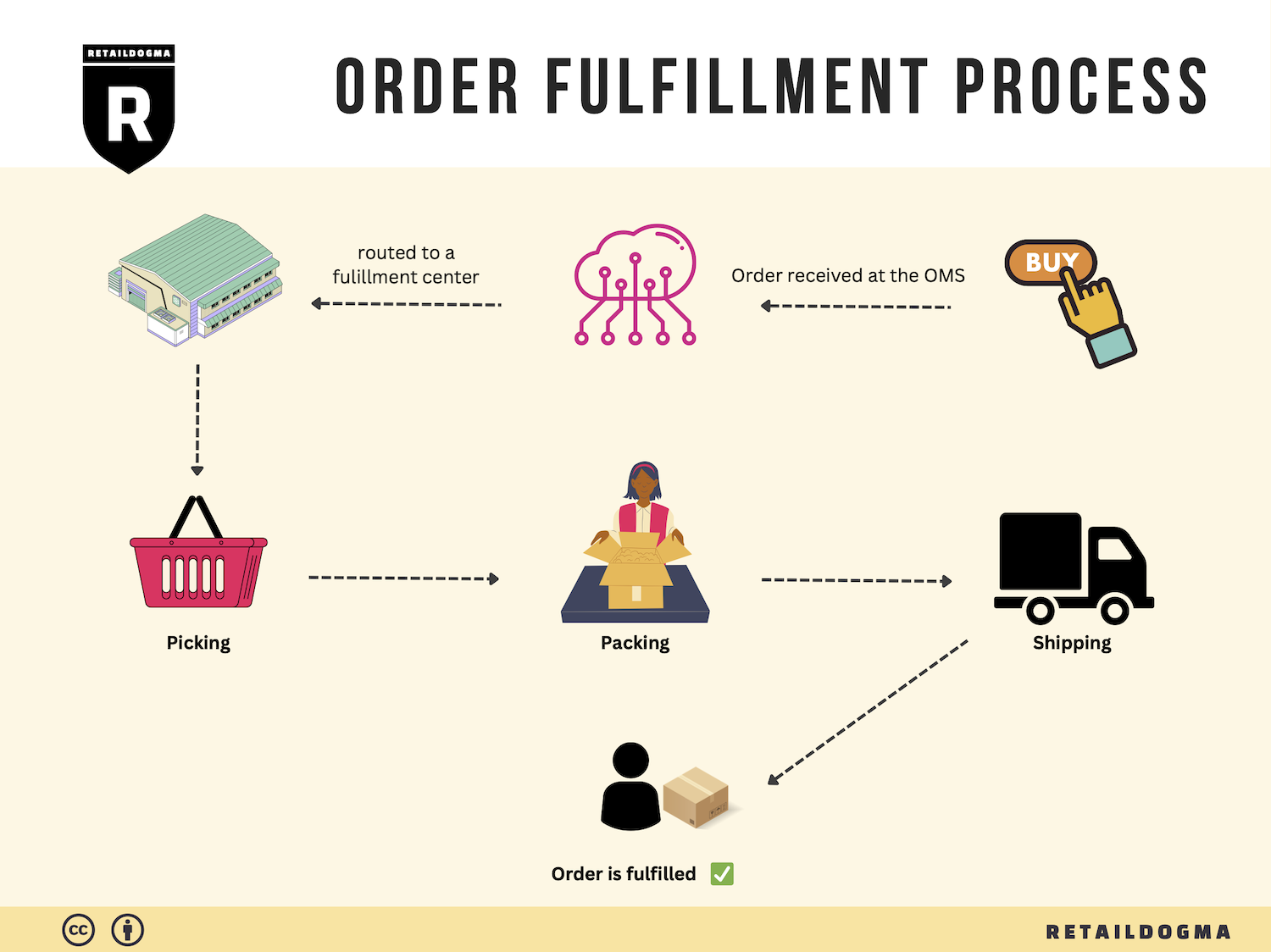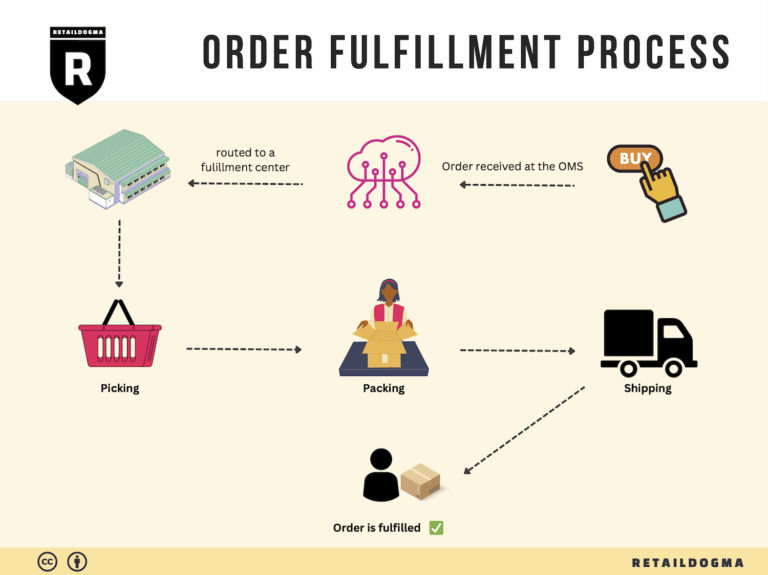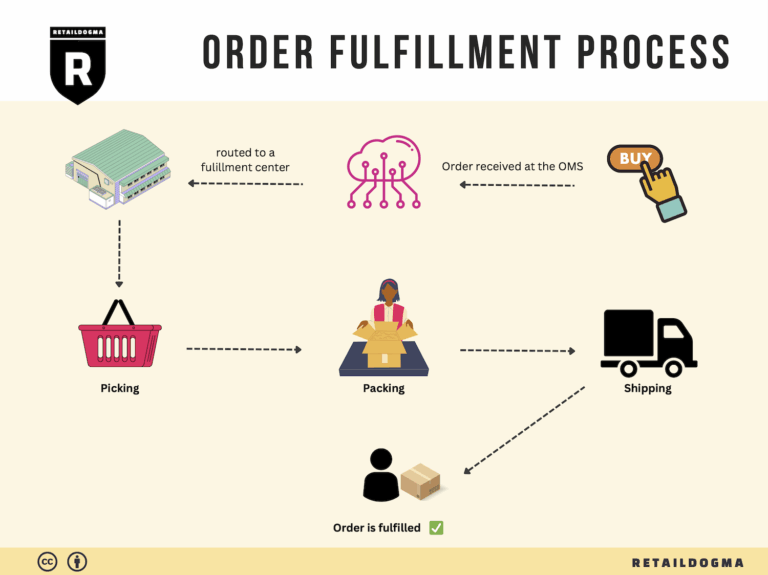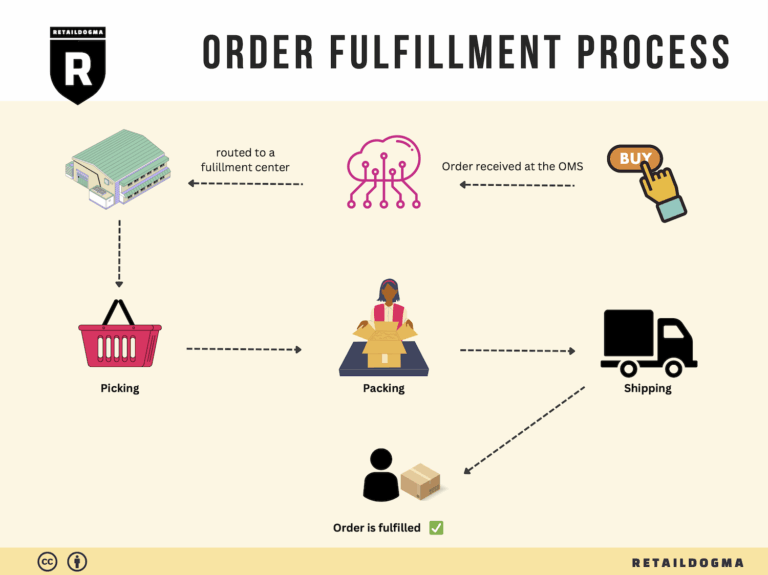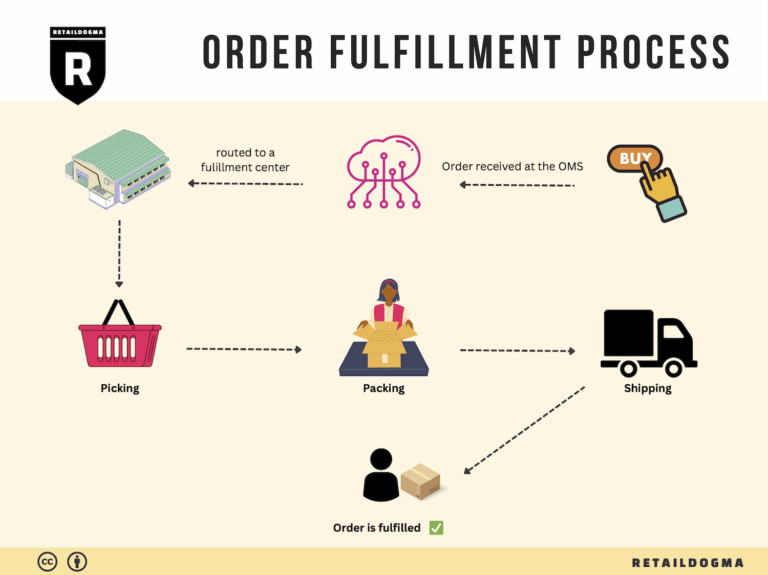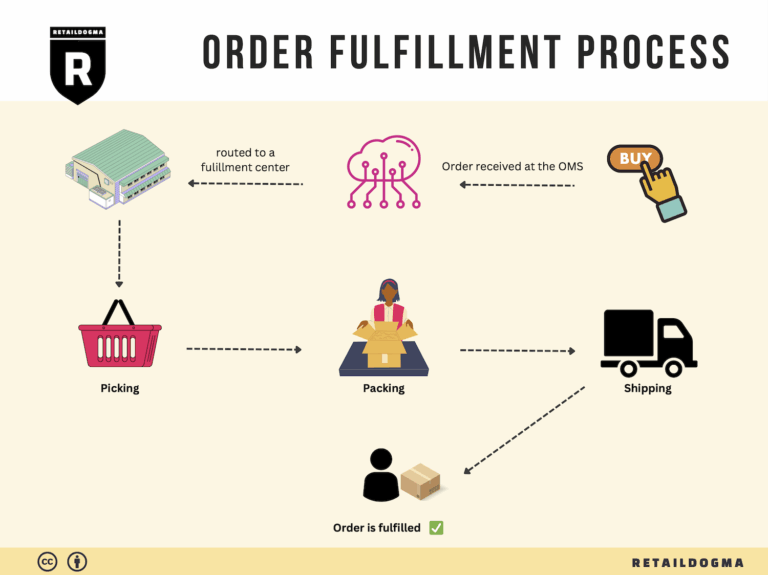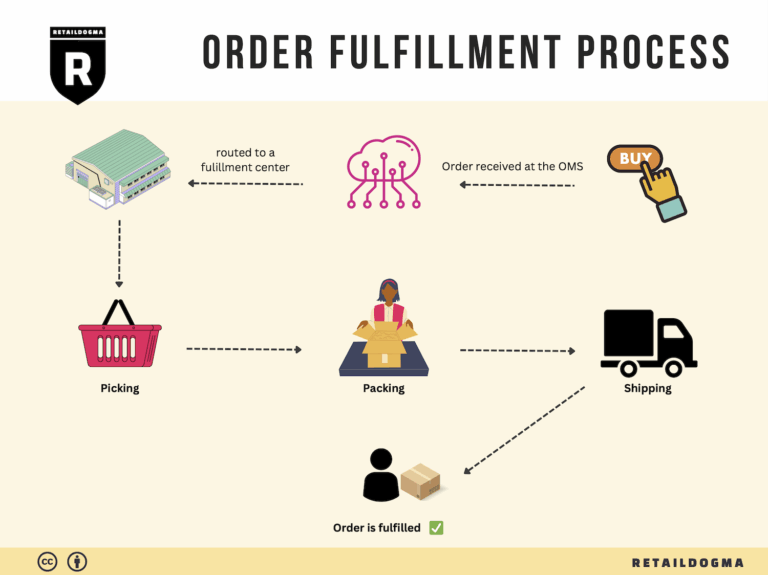What Is A Fulfillment Center? A Complete Guide (2025)
What is E-commerce Fulfillment? An Introduction for Growing Businesses
Understanding E-commerce Fulfillment: A Necessity for Growth
As your online business begins to flourish, the excitement of increased sales can quickly turn into a daunting challenge. One of the most common pain points for growing e-commerce entrepreneurs is managing the complexities of packing and shipping orders. The initial joy of receiving orders can soon become overshadowed by the overwhelming tasks of inventory management, order processing, and ensuring timely delivery. This is where e-commerce fulfillment comes into play.
At its core, fulfillment is the process of getting a product from your warehouse or supplier to your customer’s doorstep. It encompasses everything from receiving inventory to picking, packing, and shipping orders, as well as handling returns. This intricate process is crucial because it directly impacts your business’s efficiency, customer satisfaction, and ultimately, your bottom line.
In this guide, we will delve into various fulfillment models that can help streamline your operations. We will explore the benefits and challenges of working with Third-Party Logistics (3PL) providers and Fulfillment by Amazon (FBA), allowing you to assess which option best aligns with your business objectives. Understanding these models will provide clarity on how to scale your logistics effectively as your sales grow.
Additionally, we will break down the core services involved in e-commerce fulfillment, including picking, packing, shipping, and returns management. Each element plays a vital role in ensuring that your orders are processed accurately and efficiently, minimizing delays and maximizing customer satisfaction.
Choosing the right fulfillment partner can be a daunting task. We’ll provide practical insights on what to look for in a logistics partner, including technology integration, service offerings, and their ability to scale with your business.
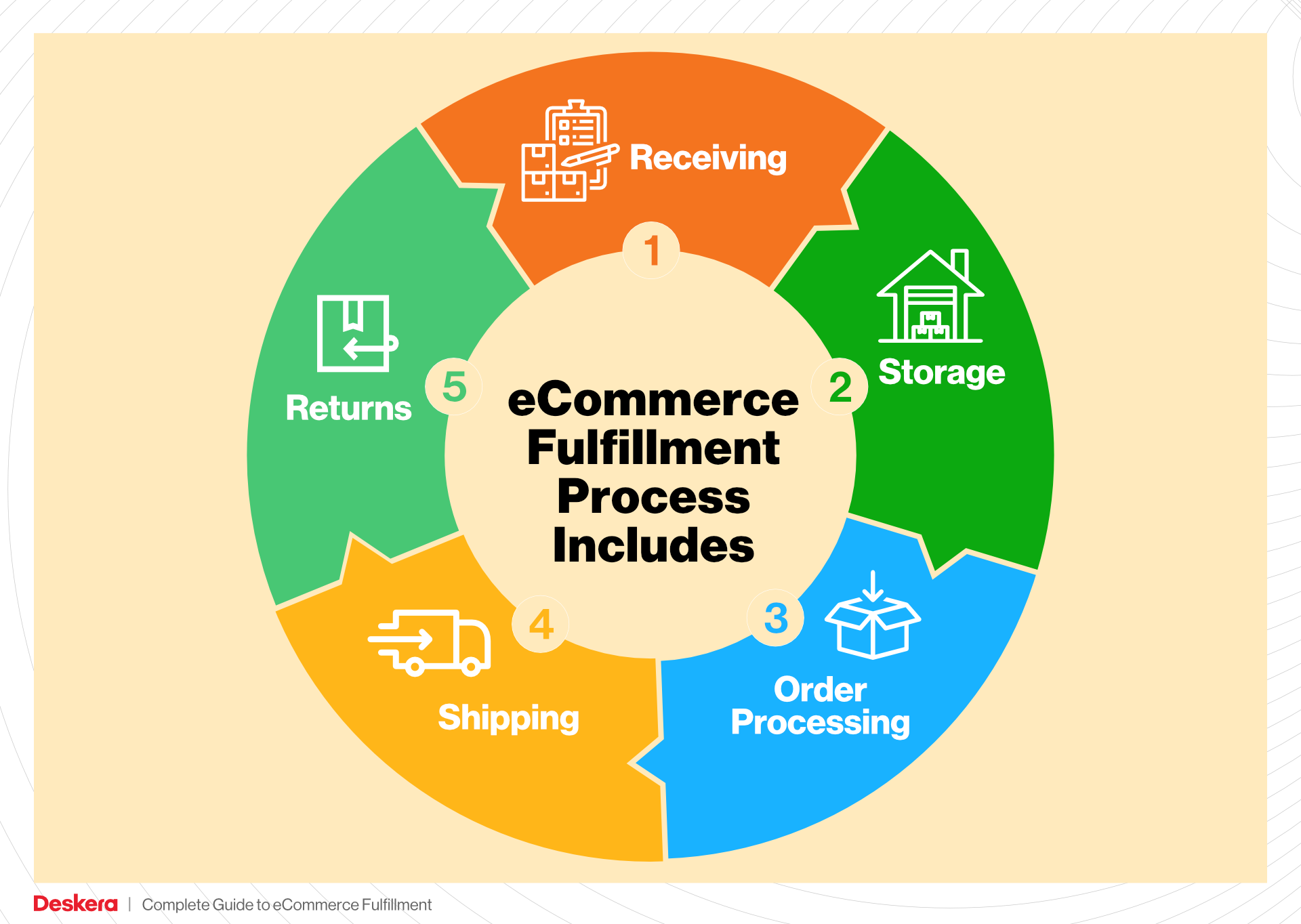
Lastly, we will address pricing structures and considerations, helping you understand the financial implications of different fulfillment options.
The goal of this guide is to empower you, the business owner, to make informed and strategic decisions about your logistics operations. By optimizing your fulfillment process, you can focus on what truly matters—growing your business and delighting your customers.
What You’ll Learn In This Guide
- What is E-commerce Fulfillment? An Introduction for Growing Businesses
- The Order Fulfillment Process: From ‘Buy’ Button to Customer’s Door
- Comparing Fulfillment Models: In-House vs. 3PL vs. Dropshipping
- A Deep Dive into Amazon FBA: Pros, Cons, and Who It’s For
- Core Services Offered by Fulfillment Centers
- How to Choose a Fulfillment Partner: A 6-Point Checklist
- Understanding Fulfillment Pricing: A Breakdown of Common Fees
- Frequently Asked Questions (FAQs) about Fulfillment
- Conclusion: Is Outsourcing Fulfillment the Right Move for Your Business?
- Important Disclaimer
The Order Fulfillment Process: From ‘Buy’ Button to Customer’s Door
1. Receiving Inventory
The order fulfillment process begins with receiving inventory from suppliers or manufacturers. During this phase, items are checked against purchase orders to ensure accuracy and quality. This step is crucial for maintaining inventory integrity and preventing discrepancies that could lead to stockouts or overstock situations.
Key Term: SKU (Stock Keeping Unit) – Each product is assigned a unique SKU, which helps in tracking inventory efficiently. Proper SKU management ensures that businesses can quickly locate items in the warehouse and maintain accurate inventory counts.
2. Warehouse Storage
Once the inventory is received and verified, it is stored in a designated area within the warehouse. Effective warehouse storage involves organizing products in a systematic manner, often categorized by size, type, or demand frequency. This organization not only enhances accessibility but also optimizes space utilization.
This step is vital because it impacts the efficiency of the picking process. The more organized the storage, the quicker and easier it is for warehouse staff to locate items when orders come in. Implementing a Warehouse Management System (WMS) can greatly assist in managing storage locations and inventory levels in real time.
Key Term: FIFO (First In, First Out) – This inventory management method ensures that older stock is sold before newer stock, reducing the risk of spoilage or obsolescence.
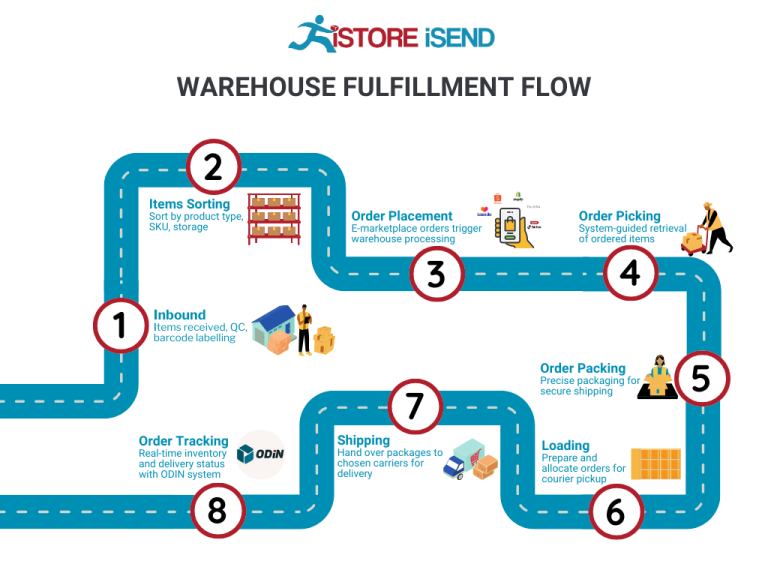
3. Order Picking
When a customer places an order, the next step is order picking. This is the process of retrieving the specific items from inventory based on the order details, typically outlined in a pick list. The picking method can vary depending on the warehouse layout and order volume, with options including piece picking, batch picking, zone picking, and wave picking.
Efficient order picking is critical as it directly affects order fulfillment speed and accuracy. The faster and more accurately items are picked, the quicker orders can be processed and shipped to customers. Investing in technology, such as barcode scanners or automated picking systems, can significantly enhance picking efficiency.
Key Term: Pick List – A document or digital list that indicates which items need to be retrieved for a particular order, including quantities and locations within the warehouse.
4. Order Packing
After items are picked, they move to the packing stage. Here, products are carefully packed into boxes with appropriate packing materials to protect them during transit. This step is essential for minimizing damage and ensuring that customers receive their orders in excellent condition.
Packing also involves labeling the packages with necessary documentation, such as shipping labels and invoices. Proper packing not only enhances the customer experience but can also reduce shipping costs by optimizing box sizes and minimizing excess space.
Key Term: Packing Slip – A document included in the package that lists the items inside, serving both as a receipt for the customer and a checklist for the packer to ensure accuracy.
5. Shipping & Delivery
The final step in the order fulfillment process is shipping and delivery. Once packages are packed, they are handed over to shipping carriers for delivery to the customer’s address. This stage includes selecting the best shipping options based on cost, speed, and reliability.
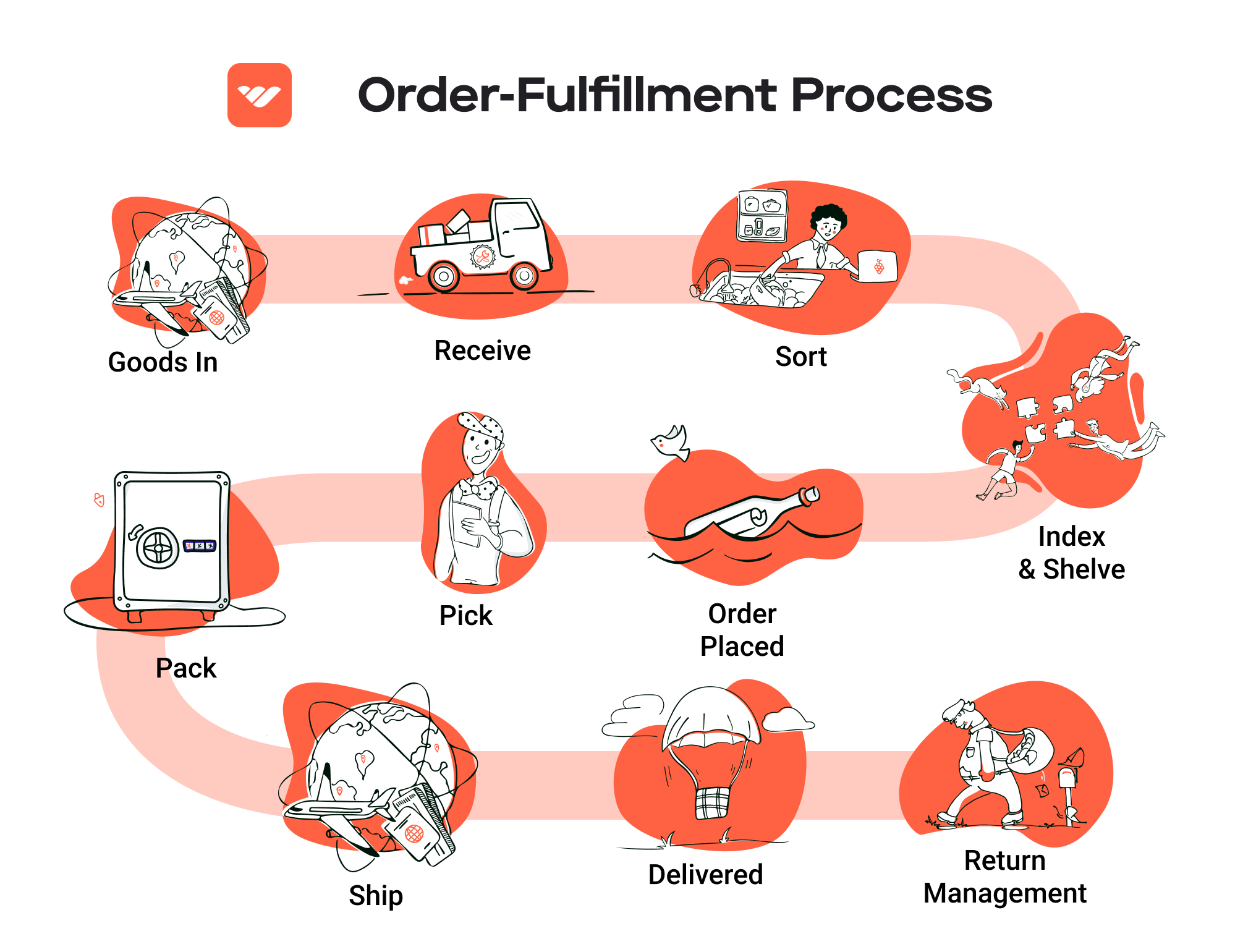
Timely and accurate shipping is paramount for customer satisfaction. Businesses often use tracking systems that allow customers to monitor their orders in real time, enhancing transparency and trust. Efficient shipping practices can also lead to cost savings, especially when leveraging bulk shipping discounts.
Key Term: Last-Mile Delivery – This term refers to the final leg of the delivery journey, where the package is transported from a distribution center to the end customer’s doorstep. Optimizing last-mile delivery is crucial for improving delivery times and reducing overall logistics costs.
By understanding and optimizing each of these steps in the order fulfillment process, e-commerce businesses can enhance operational efficiency, reduce costs, and improve customer satisfaction, ultimately paving the way for scalable growth.
Comparing Fulfillment Models: In-House vs. 3PL vs. Dropshipping
Fulfillment Models Comparison
| Model | Who Handles Inventory | Best For (Business Stage) | Key Advantage | Key Disadvantage |
|---|---|---|---|---|
| In-House Fulfillment | Business itself | Startups to established | Full control over operations | High overhead costs |
| Third-Party Logistics (3PL) | Third-party provider | Growth stage | Scalability and expertise | Less control over inventory |
| Dropshipping | Supplier | New entrants or niche | Low initial investment | Longer shipping times and less control |
In-House Fulfillment
In-house fulfillment involves managing your inventory and order processing within your own facilities. This model allows e-commerce businesses to have complete control over their operations, from inventory management to shipping. For startups and established businesses, in-house fulfillment can enhance brand integrity, as they can ensure that every aspect of the order process aligns with their brand values and customer expectations. However, the key disadvantage is the high overhead costs associated with warehousing, staffing, and technology investments. Maintaining an in-house operation requires significant resources, which can strain the budget, especially for small businesses. Moreover, as order volumes increase, scaling operations can become cumbersome, requiring more space and labor.
Third-Party Logistics (3PL)
Third-party logistics providers (3PL) offer a flexible solution for e-commerce businesses looking to streamline their operations. In this model, a third-party provider manages inventory, warehousing, and shipping on behalf of the business. This is particularly beneficial for businesses in the growth stage, as they can leverage the provider’s expertise in logistics, technology, and established infrastructure. 3PLs often have multiple warehouses, which can facilitate faster shipping times and cost savings through economies of scale. However, the downside is that businesses relinquish some control over inventory management and fulfillment processes. This can lead to potential issues with accuracy and customer service if the 3PL does not align with the brand’s standards or operational goals.
Dropshipping
Dropshipping is a fulfillment model where the retailer does not hold inventory but instead relies on suppliers to ship products directly to customers. This model is particularly appealing for new entrants or businesses targeting niche markets, as it requires minimal upfront investment. Entrepreneurs can test product ideas without the financial burden of inventory, making it an attractive option for those with limited capital. However, dropshipping has significant downsides. Shipping times can be longer since the supplier handles fulfillment, which can negatively impact customer satisfaction. Additionally, businesses have limited control over product quality and inventory levels, leading to potential stockouts or discrepancies that can harm the brand’s reputation.
Conclusion
Choosing the right fulfillment model is critical for scaling an e-commerce business. In-house fulfillment offers control and consistency but comes with high costs and complexity. Third-party logistics provide scalability and expertise, ideal for growing companies, while dropshipping allows for low-risk entry into the market but sacrifices control and can lead to longer delivery times. As businesses evaluate their options, they must consider their unique needs, growth ambitions, and the customer experience they wish to deliver. Each model has its place, and understanding the trade-offs is essential for making an informed decision that aligns with overall business strategy.
A Deep Dive into Amazon FBA: Pros, Cons, and Who It’s For
Understanding Fulfillment by Amazon (FBA)
Fulfillment by Amazon (FBA) is a service that allows e-commerce sellers to store their products in Amazon’s fulfillment centers. Amazon then takes care of storage, packaging, shipping, and customer service for these products. This service is particularly attractive for small to medium-sized businesses looking to scale their operations without the burden of managing logistics themselves. Here’s a detailed breakdown of how FBA works, its benefits and drawbacks, and who it is best suited for.
How FBA Works
-
Product Storage: Sellers send their products to Amazon’s warehouses. Amazon handles the logistics of storing these products, ensuring they are ready to ship when an order is placed.
-
Order Fulfillment: When a customer places an order, Amazon picks, packs, and ships the product on behalf of the seller. This process is streamlined through Amazon’s sophisticated inventory management system.
-
Customer Service: Amazon also manages customer inquiries and returns related to the FBA products, allowing sellers to focus on other aspects of their business.
-
Prime Eligibility: Products fulfilled through FBA are eligible for Amazon Prime, which significantly enhances their visibility and appeal to customers.
-
Multi-Channel Fulfillment: Sellers can also use FBA to fulfill orders from other sales channels, such as their own websites or other online marketplaces, further streamlining their operations.
Pros of Using FBA
-
Prime Eligibility: One of the most significant advantages of using FBA is the ability to offer Prime shipping to customers. This can lead to increased sales, as many shoppers filter their searches to show only Prime-eligible items.
-
Customer Trust: Amazon has built a reputation for reliability and customer service. By using FBA, sellers can leverage this trust, which can lead to higher conversion rates.
-
Scalability: FBA allows sellers to scale their operations without the need to invest in warehousing and logistics infrastructure. As sales grow, Amazon can handle increased order volumes seamlessly.
-
Time Savings: Outsourcing fulfillment to Amazon frees up time for sellers to focus on product development, marketing, and other strategic initiatives rather than logistics.
-
Multi-Channel Fulfillment: Sellers can use FBA for orders placed on other platforms, allowing for consistent shipping and handling across different sales channels.
-
Advanced Logistics: Amazon’s vast network of fulfillment centers enables faster shipping times, which can be a competitive advantage in today’s fast-paced e-commerce environment.
Cons of Using FBA
-
High Fees: While FBA can save time, it comes with costs. Sellers must pay for storage space, fulfillment fees, and additional charges for services like returns. These fees can add up, particularly for sellers with lower margins.
-
Strict Inventory Rules: Amazon has stringent rules regarding inventory management, including limits on how much inventory can be stored and how long it can remain in the warehouse. Sellers must carefully manage their stock levels to avoid penalties.
-
Commingling Risks: FBA products may be commingled with those of other sellers. This can lead to issues with brand integrity, as sellers may receive returns of products that are not theirs, complicating inventory management.
-
Less Control Over Branding: While Amazon handles the logistics, sellers have limited control over packaging and branding. This can impact the unboxing experience, which is vital for brand differentiation.
-
Dependency on Amazon: Relying on FBA means that sellers are heavily dependent on Amazon’s policies and procedures. Changes in Amazon’s terms of service or fulfillment processes can significantly impact their business.
Who is FBA Best For?
Fulfillment by Amazon is ideal for:
-
Small to Medium-Sized Businesses: Companies looking to scale quickly without investing heavily in logistics infrastructure can benefit greatly from FBA.
-
Brands with High Volume Sales: Sellers with a steady stream of orders will find the efficiency of FBA to be a significant asset, helping to reduce shipping times and improve customer satisfaction.
-
New Sellers: Entrepreneurs entering the e-commerce space can leverage FBA to quickly establish a presence on Amazon, benefiting from the platform’s massive customer base and trusted service.
-
Multi-Channel Sellers: Businesses that sell on multiple platforms can use FBA for streamlined fulfillment across all channels, maintaining consistency in shipping and customer service.
-
Brands Focused on Growth: Companies that prioritize growth and customer acquisition will find that FBA provides the necessary logistics support to scale operations effectively.
In conclusion, Fulfillment by Amazon offers a robust solution for e-commerce sellers looking to streamline their operations and enhance customer satisfaction. However, it is essential to weigh the pros and cons carefully, considering factors such as fees, inventory management, and brand control, to determine if FBA aligns with your business goals and operational strategy.
Core Services Offered by Fulfillment Centers
Inventory Management & Warehousing
Effective inventory management is a cornerstone of any successful e-commerce operation. Fulfillment centers provide comprehensive inventory management services that streamline the storage, tracking, and replenishment of stock. These centers utilize sophisticated Warehouse Management Systems (WMS) to monitor inventory levels in real-time, ensuring that businesses can maintain optimal stock levels without overcommitting resources.
Benefits:
– Reduced Stockouts and Overstocks: By having a clear view of inventory levels, e-commerce businesses can avoid the pitfalls of stockouts—losing potential sales—and overstocks, which tie up capital and increase storage costs.
– Improved Accuracy: Automated inventory tracking minimizes human error, ensuring that the correct quantities are always available for order fulfillment.
– Scalability: As your business grows, fulfillment centers can easily adapt to increased inventory needs, allowing you to scale operations without the headaches of managing additional warehouse space.
Pick and Pack Services
Pick and pack services are integral to the order fulfillment process. This involves the selection of items from inventory (picking) and packaging them appropriately for shipment (packing). Fulfillment centers typically employ various picking strategies, such as batch picking or wave picking, to optimize the efficiency of these operations.
Benefits:
– Speed and Efficiency: By employing advanced picking strategies and technology, fulfillment centers can dramatically reduce the time taken to process orders. This translates to faster delivery times for customers, enhancing satisfaction and loyalty.
– Cost-Effectiveness: Streamlined pick and pack processes reduce labor costs and minimize shipping expenses by optimizing packaging sizes and materials.
– Quality Control: Many fulfillment centers implement rigorous quality control measures during the pick and pack process, ensuring that the right products are shipped in perfect condition, which further enhances customer satisfaction.
Kitting and Assembly
Kitting and assembly services allow e-commerce businesses to bundle multiple products together into a single package or prepare items for sale. This is particularly useful for businesses that sell items that complement each other or require assembly before they can be sold. Fulfillment centers can handle these tasks efficiently, ensuring that products are ready for shipment as a cohesive unit.
Benefits:
– Enhanced Customer Experience: Kitting allows businesses to offer bundled products at a discounted price, which can increase average order value and improve customer satisfaction by providing value.
– Streamlined Operations: By outsourcing kitting and assembly to fulfillment centers, businesses can focus on their core operations, such as marketing and customer service, rather than on the logistics of product assembly.
– Inventory Optimization: Kitting can help manage inventory more effectively by allowing businesses to move slow-moving items alongside fast-selling ones, thereby reducing excess stock.
Returns Management (Reverse Logistics)
Returns management, or reverse logistics, is a critical component of e-commerce fulfillment that involves processing returns efficiently. Fulfillment centers facilitate this process by handling returns in a way that minimizes disruption to the business and maximizes recovery of value from returned items.
Benefits:
– Streamlined Process: Fulfillment centers have established processes for handling returns, including inspection, restocking, and disposition of returned goods. This reduces the burden on e-commerce businesses and ensures that returns are processed quickly.
– Customer Satisfaction: A smooth returns process enhances customer trust and satisfaction. Customers are more likely to purchase from businesses that offer hassle-free returns, knowing they can return items easily if needed.
– Data Insights: Fulfillment centers can provide valuable analytics on return trends, helping businesses understand why products are being returned and allowing them to make informed decisions about inventory and product offerings.
In conclusion, partnering with a fulfillment center offers e-commerce businesses a suite of essential services that enhance operational efficiency, improve customer satisfaction, and support scalability. By leveraging these core services, businesses can focus on growth while ensuring that their logistics processes are handled expertly and efficiently.
How to Choose a Fulfillment Partner: A 6-Point Checklist
Location & Warehouse Network
Why It Matters:
The geographic location of your fulfillment partner’s warehouses can significantly impact shipping costs and delivery times. A partner with a well-distributed network of warehouses can help you reach customers more quickly and affordably, particularly if you have a nationwide or international customer base.
Questions to Ask:
– How many warehouses do you operate, and where are they located?
– Can you store inventory in multiple locations to optimize shipping times?
– What is your average shipping time to major metropolitan areas?
– Do you have the capability to manage international shipments if needed?
Technology & Integrations
Why It Matters:
In today’s fast-paced e-commerce environment, effective technology is essential for seamless operations. A partner that offers a robust Warehouse Management System (WMS) can enhance order accuracy, inventory tracking, and reporting capabilities. Additionally, integration with your e-commerce platform is critical for real-time updates.
Questions to Ask:
– What type of technology do you use for order management and inventory tracking?
– Can your system integrate with popular e-commerce platforms (e.g., Shopify, WooCommerce)?
– Do you offer real-time inventory updates and order tracking for customers?
– How do you ensure data security and compliance with privacy regulations?
Specializations (e.g., Cold Storage, Oversized Items)
Why It Matters:
Different businesses have unique fulfillment needs. Whether you require temperature-controlled storage for perishable goods or the ability to handle oversized items, it’s crucial to partner with a fulfillment center that specializes in your specific requirements.
Questions to Ask:
– Do you have specialized facilities for specific types of products (e.g., cold storage, fragile items)?
– What experience do you have in handling products similar to mine?
– Can you accommodate seasonal fluctuations in inventory?
– Are there any restrictions on the types of products you can handle?
Scalability & Capacity
Why It Matters:
As your business grows, your fulfillment needs will likely change. A good fulfillment partner should be able to scale their services to accommodate your growth without compromising on quality or efficiency. This includes managing increased order volumes during peak seasons.
Questions to Ask:
– How do you handle fluctuations in order volume, especially during peak seasons?
– What is your current capacity, and how quickly can you scale up if needed?
– Can you support multiple sales channels (e.g., online, retail, subscription boxes)?
– What contingency plans do you have in place for unexpected spikes in demand?
Pricing and Contracts
Why It Matters:
Understanding the pricing structure and contract terms is critical to avoid unexpected costs that can impact your bottom line. Transparency in pricing helps you budget accurately and assess the overall value of the partnership.
Questions to Ask:
– What is your pricing model (e.g., per order, per item, storage fees)?
– Are there additional fees for services such as returns processing or special packaging?
– How long are your contracts, and what are the termination clauses?
– Do you offer volume discounts or incentives for long-term commitments?
Customer Support & Reviews
Why It Matters:
Strong customer support is essential for resolving issues quickly and maintaining smooth operations. Additionally, checking reviews and testimonials can provide insight into the partner’s reliability and service quality.
Questions to Ask:
– What kind of customer support do you offer (e.g., dedicated account manager, 24/7 support)?
– How do you handle issues such as lost or damaged shipments?
– Can you provide references or case studies from businesses similar to mine?
– What is the average response time for customer inquiries or issues?
Conclusion
Choosing the right fulfillment partner is a critical decision that can significantly impact your e-commerce business’s success. By carefully considering these six key areas—Location & Warehouse Network, Technology & Integrations, Specializations, Scalability & Capacity, Pricing and Contracts, and Customer Support & Reviews—you can ensure that you select a partner that aligns with your operational needs and growth objectives. Take the time to ask the right questions, and don’t hesitate to seek out multiple partners to compare their offerings before making a final decision.
Understanding Fulfillment Pricing: A Breakdown of Common Fees
Initial Setup Fees
When partnering with a fulfillment service, businesses often encounter initial setup fees. These fees cover the costs associated with onboarding your account and preparing your inventory for storage and fulfillment. Initial setup typically includes the configuration of your account in the provider’s system, integration with your e-commerce platform, and initial inventory assessment.
Calculation: Initial setup fees vary widely among fulfillment centers but can range from a few hundred to several thousand dollars. Factors influencing the fee include the complexity of your operations, the number of SKUs, and the level of customization required for your fulfillment processes.
Receiving Fees
Receiving fees are charged when your inventory arrives at the fulfillment center. This fee compensates the warehouse for inspecting, counting, and storing your products. Proper receiving processes ensure that your inventory is accurately accounted for and ready for subsequent picking and packing.
Calculation: These fees are typically charged per pallet or per hour of labor involved in the receiving process. For example, a fulfillment center may charge a flat rate of $20 per pallet received or $50 per hour for labor. The total cost will depend on the volume of your shipments and the time taken to process them.
Storage Fees (per pallet/bin)
Storage fees are incurred for the physical space your inventory occupies within the warehouse. These fees can be structured as a monthly charge based on the amount of space used, whether measured in pallets, bins, or cubic footage.
Calculation: Storage fees can vary significantly, with typical rates ranging from $10 to $50 per pallet per month. Some fulfillment centers may offer tiered pricing based on the volume of inventory stored, meaning businesses with larger quantities may benefit from reduced rates. It’s essential to understand how your inventory turnover affects storage costs, as slow-moving products can lead to higher fees.
Pick & Pack Fees (per item/order)
Pick and pack fees are the charges associated with selecting items from inventory (picking) and preparing them for shipment (packing). These fees are crucial for e-commerce businesses, as they directly impact the speed and accuracy of order fulfillment.
Calculation: Pick and pack fees can be charged per item or per order. For instance, a fulfillment center might charge $1.50 per item picked and packed or a flat fee of $3.00 per order, regardless of the number of items. The total cost will depend on your order volume, the average number of items per order, and the complexity of the picking process (e.g., if it requires special handling).
Shipping Fees
Shipping fees encompass the costs associated with transporting your products from the fulfillment center to your customers. These fees can be influenced by several factors, including the shipping carrier chosen, the destination, the weight and dimensions of the packages, and the service level (standard, expedited, etc.).
Calculation: Shipping fees are often calculated based on the weight and size of the package, as well as the distance to the delivery location. Many fulfillment centers negotiate bulk shipping discounts with carriers, which can lower your overall costs. For example, shipping a standard package may cost $5 for local delivery but could increase to $15 for international shipping. It’s crucial to factor in these costs when determining your pricing strategy.
Tips for Getting an Accurate Quote
-
Understand Your Needs: Clearly outline your fulfillment requirements, including order volume, inventory types, and specific service level expectations. This information will help providers give you a tailored quote.
-
Request Detailed Pricing Structures: Ask for a breakdown of all potential fees, including hidden costs that may arise, such as returns processing or special packaging requirements.
-
Compare Multiple Providers: Don’t settle for the first quote you receive. Compare offers from several fulfillment centers to find the best pricing and service level combination.
-
Negotiate Terms: Many fulfillment providers are willing to negotiate pricing, especially if you can offer a high volume of business. Don’t hesitate to discuss your budget constraints and seek discounts.
-
Consider Long-term Contracts: Some fulfillment centers offer lower rates for businesses willing to commit to longer-term contracts. Evaluate whether this could be beneficial for your operations.
By understanding these common fulfillment pricing models, e-commerce businesses can make informed decisions that enhance their logistics operations while controlling costs.
Frequently Asked Questions (FAQs) about Fulfillment
1. What is pick and pack fulfillment?
Pick and pack fulfillment is a logistics process where products are selected (picked) from inventory and then packaged (packed) for shipment to customers. This process occurs after an order is placed and is critical for ensuring timely and accurate delivery.
2. How does pick and pack fulfillment work?
The process begins with the receipt of an order. Warehouse staff use picking lists to locate and retrieve the items specified in the order. Once all items are collected, they are packed into suitable boxes, ensuring the correct packing materials are used to protect the products during transit. Finally, the package is labeled and shipped to the customer.
3. What is the difference between a warehouse and a fulfillment center?
While both serve as storage facilities, a warehouse primarily focuses on storing goods, whereas a fulfillment center is designed specifically for order processing and shipping. Fulfillment centers have systems in place to handle the entire order fulfillment process, including picking, packing, and shipping, often with a focus on speed and efficiency.
4. What is a 3PL?
A 3PL, or third-party logistics provider, is a company that offers outsourced logistics services, including warehousing, fulfillment, and transportation. By partnering with a 3PL, businesses can leverage their expertise and resources to streamline operations and enhance supply chain efficiency.
5. How much do fulfillment services cost?
Fulfillment service costs vary widely based on factors such as order volume, the complexity of the fulfillment process, storage needs, and shipping methods. Common fees include picking and packing fees, storage fees, and shipping costs. It’s essential to obtain quotes from multiple providers to understand the pricing structure and find the best fit for your business.
6. What are the benefits of using pick and pack fulfillment?
Using pick and pack fulfillment can significantly enhance operational efficiency by reducing order processing times, minimizing errors, and improving customer satisfaction. It allows businesses to scale their operations without the need for extensive in-house logistics infrastructure.
7. What are common picking strategies used in warehouses?
Common picking strategies include:
– Piece Picking: Picking items individually for each order.
– Batch Picking: Collecting multiple orders simultaneously in one trip.
– Zone Picking: Assigning pickers to specific areas of the warehouse.
– Wave Picking: Combining batch and zone picking, where pickers handle multiple orders within a designated area.
8. How can technology improve pick and pack fulfillment?
Technology plays a crucial role in enhancing pick and pack fulfillment by automating processes, improving inventory management, and providing real-time data on order status. Warehouse Management Systems (WMS) help optimize picking routes, track inventory levels, and reduce errors, ultimately leading to faster processing times.
9. What is the importance of packing in the fulfillment process?
Packing is vital for ensuring that products are delivered to customers safely and in good condition. Proper packing minimizes the risk of damage during transit, reduces shipping costs by optimizing box sizes, and enhances the unboxing experience, which can positively impact customer satisfaction and brand perception.
10. How can I choose the right fulfillment partner for my business?
When selecting a fulfillment partner, consider factors such as their experience in your industry, technology capabilities, geographic reach, customer service, and pricing structure. It’s also beneficial to request case studies or testimonials from other businesses to gauge their performance and reliability.
Conclusion: Is Outsourcing Fulfillment the Right Move for Your Business?
Evaluating the Benefits of Outsourcing Fulfillment
Outsourcing fulfillment can be a transformative decision for e-commerce businesses seeking to scale efficiently. One of the most compelling advantages is the significant time savings. By delegating the pick and pack process to a specialized fulfillment partner, you can focus on strategic initiatives such as marketing, product development, and customer engagement. This shift allows you to allocate your resources where they can generate the most value, rather than getting bogged down in logistical challenges.
Scalability is another critical benefit of partnering with a fulfillment service. As your business grows, so do your operational demands. A fulfillment provider can seamlessly adapt to fluctuating order volumes, ensuring that you can meet customer expectations without the headaches of managing additional warehouse space or labor. This flexibility is essential for maintaining high service levels, especially during peak seasons or promotional events.
Moreover, leveraging the expertise of a fulfillment partner means you gain access to industry best practices, advanced technology, and efficient processes that can enhance order accuracy and speed. This not only improves customer satisfaction but can also lead to reduced shipping costs through optimized logistics.
However, the success of outsourcing fulfillment hinges on choosing the right partner. Look for a provider that aligns with your business goals, offers transparent pricing, and has a proven track record of reliability and accuracy.
Take Action
Now is the time to assess your current shipping processes. Conduct an audit to identify bottlenecks and inefficiencies. Ask yourself: Are you ready to transition to a fulfillment partner that can support your growth? If so, consider reaching out to potential providers and explore how they can help you scale your e-commerce operations effectively.
Important Disclaimer
⚠️ Important Disclaimer
The information in this guide is for educational purposes. Fulfillment services, pricing, and platform features change frequently. Always conduct your own due diligence and consult with providers directly before making business decisions.
